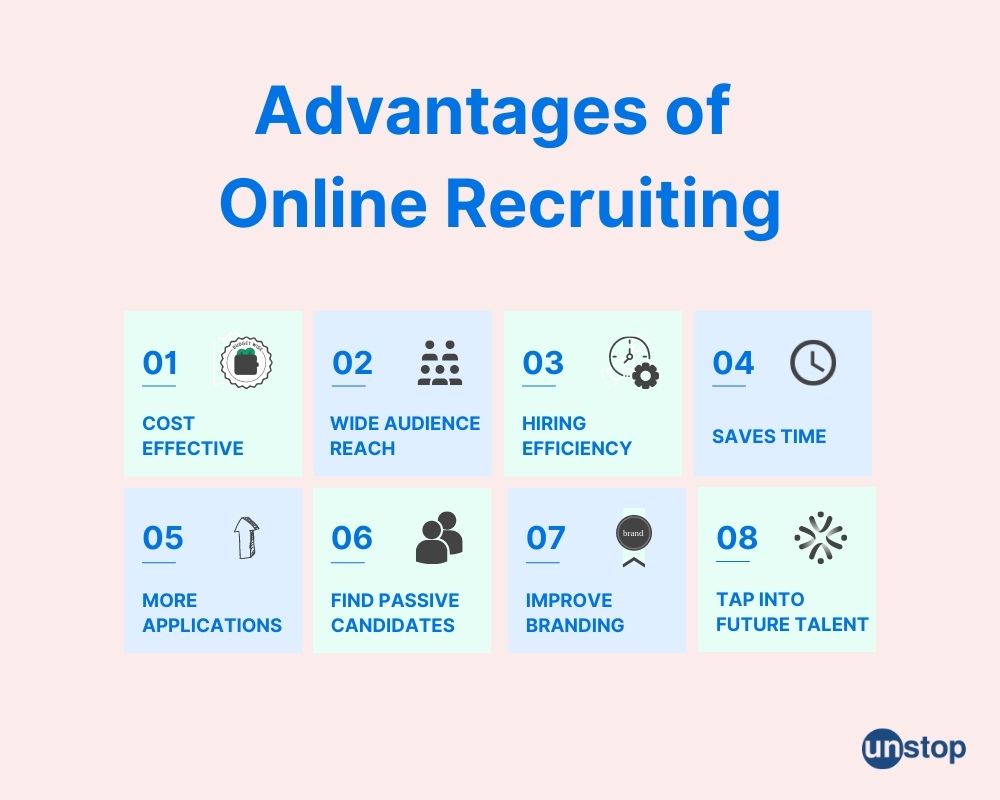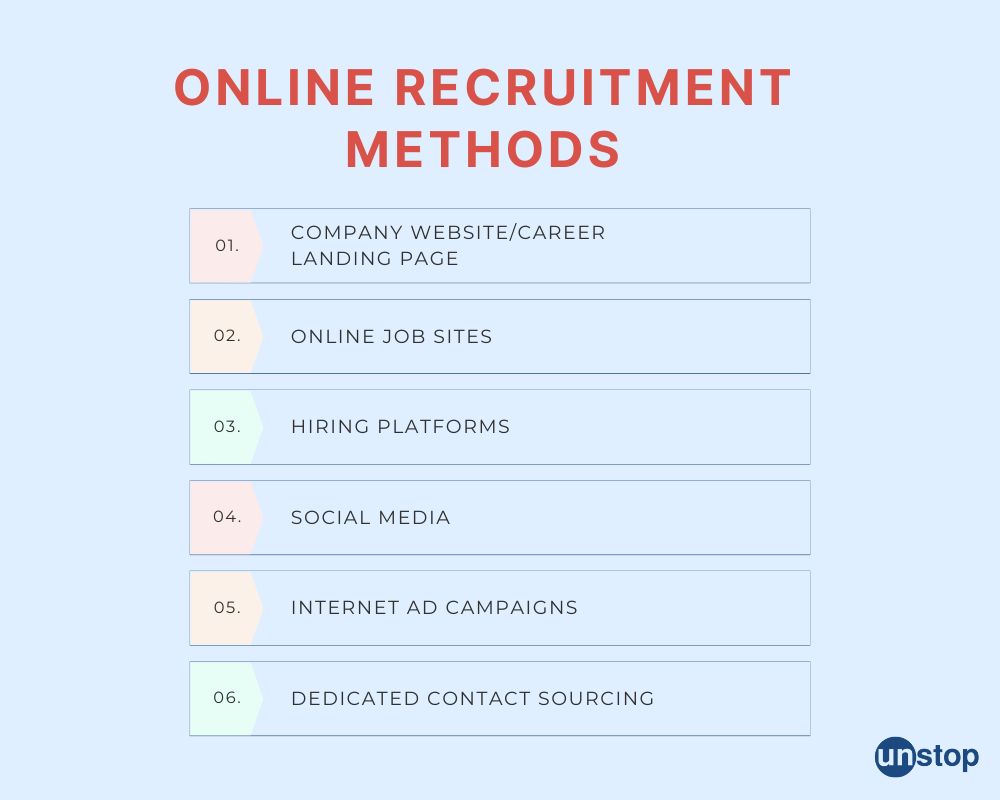- What Is Online Recruiting?
- Steps of Online Hiring
- Advantages Of Online Recruitment
- Disadvantages Of Online Recruitment
- How To Recruit Employees Online?
- Measuring The Effectiveness Of Online Recruiting
- Online Recruiting: Best Practices
A Detailed Guide To Online Recruiting AKA The Future Of Hiring

Technology is no longer permeating slowly into society's fabric - it's fast becoming a part of every process, function and activity that runs the world. From the letters we write to the tickets we book, digital solutions are everywhere around us, providing answers to problems we hadn't even anticipated facing.
The pandemic-induced lockdown may have accelerated their growth, but digital solutions have now become a preferred choice across most, if not all industries and functions. This includes the digitization of parts of the hiring process and the emergence of online recruitment, or virtual hiring.
What Is Online Recruiting?
Definition: Online recruiting, also referred to as e-recruitment or virtual hiring, is a recruitment method where online resources and web-based solutions are used to source, assess and hire candidates.
Common tools: Some of the most common tools used for online recruitment are online job boards, online advertising, social media platforms, company websites, video conferencing software, etc.
Online recruitment is widely considered to be faster and more efficient than traditional recruitment methods. It helps save considerable time and effort by minimizing the dependence on manual labor and is more flexible than traditional recruitment.
For example, instead of booking a venue or blocking a room to interview potential candidates, hiring managers can interview them from the comfort of their home or office desk, using video conferencing.
Today, online recruiting has become immensely popular with both job seekers and employers - especially in India. As per reports, 86% of organizations shifted to virtual hiring methods during the pandemic. Even before the pandemic, India scored above its counterparts when it came to favouring online recruitment.
Media reports stated that as per a 2017 survey by global advisory firm Korn Ferry, 53% of Indian talent acquisition (TA) professionals use applicant tracking systems (ATS) and video interviews, each, for recruitment - their global counterparts lag at 48% and 46%, respectively. The writing on the wall, or rather on the desktop and handheld screens is clear - online recruitment is the future of hiring.

Steps of Online Hiring

Even though virtual hiring or online recruitment has become fairly common, not every organization gets it right. Here is a basic step-by-step approach to the online recruitment process:
Sourcing candidates
Similar to traditional hiring, online hiring also starts with specifying the job role and sourcing suitable candidates for the role. Organizations can use hiring platforms, job portals, social media platforms, and even the company website to advertise the job. Ensure that the job advertisement mentions the application deadline. Include relevant details about the application process and ensure that all links (application form link or resume submission link, etc.) are working before taking the advert live.
Pro Tip: Make sure that your internet ad campaigns and job descriptions are search engine optimized to stand out from the competition and reach the target audience.
Sorting applicants
After receiving the applications, it's time to screen the resumes and applications of candidates and find qualified candidates for the role. Companies can employ a threshold to determine if an application passes or fails.
Pro Tip: Use web-based pre-screening tools to sort through resumes and screen applicants, especially when there is a large volume of applications or the talent pool is very deep. This helps filter out unsuitable candidates, who don't meet the basic educational criteria or experience required for the role.
Assessing shortlisted candidates
After initially shortlisting the applications, it's time to assess the prospective candidates for requisite skills. The assessment framework should be thorough and align with the requirements of the position. Before starting the recruiting process, organizations need to decide the types of assessments and the number of rounds.
Pro Tip: In case of online recruiting, test online assessment tools in advance i.e., if it's an online test, ensure all questions are loading and answers and correctly marked. For interviews, make sure you have appropriate video interviewing tools.
Extending the offer
Once a candidate has cleared the assessment, it's time to extend the offer. Most organizations opt for e-mail communication when extending the offer. The offer letter can be shared as an attachment. It should contain all relevant details, from the detailed compensation package to the joining date, etc. The accompanying e-mail should always include a CTA (Call To Action) for the applicant - to accept the offer, officially, via email.
Pro Tip: Since offer letters contain sensitive information, organizations can opt to safeguard the content using additional security measures - like setting an expiration date for the email, sending emails in confidential mode, etc.
Important: From the time of shortlisting candidates, maintain e-mail communication to contact candidates for every stage of the recruitment process. This helps you track the time-to-hire - an important metric to measure the effectiveness of recruitment. It also helps identify bottlenecks in the process and manage unexpected delays.
Advantages Of Online Recruitment

Here are some of the key advantages of online recruitment:
Cost-effective
One of the biggest advantages of online recruitment is that it has lower recruiting costs than traditional hiring. Many online recruitment tools, like job boards, social media platforms, etc. are free to use - though there may be a charge for boosting or advertising your post. Comparatively, recruiting via newspapers, career fairs, or even campuses, requires significant monetary investment.
Online recruitment requires lesser manpower than traditional recruiting and thus, saves considerable labor costs for the organization.
Wider audience reach
Compared to traditional recruitment methods, online recruitment reaches a wider group of candidates in a shorter amount of time and with fewer resources. Not only do social media sites and websites enjoy a wider reach, but they're also more durable. An ad in a newspaper lasts a day - social media posts last forever (or at least, till you delete them).
Pro Tip: Use promotional videos and social media to showcase the company culture. A video clip featuring current employees, that highlights the company perks, core values and culture is a great way to attract prospective employees. A dedicated recruitment video can be a standard fixture for initial communication with applicants and need not change with every new job advert.
Improved hiring efficiency
Online recruitment offers a bundle of benefits that improve hiring efficiency. For starters, it's more dynamic and flexible - job adverts can be easily modified and updated for free, or at a fraction of cost. Even for job seekers, online recruitment is more accessible.
Take for example a hackathon to hire students from engineering colleges. Students from across the globe can participate in an online hackathon, as long as they have a working computer and internet connection. But it's significantly more difficult for candidates to travel to a physical location for a hackathon.
Saves time
Online recruitment is known to save time. Web-based can shorten the time taken for various parts of the hiring process, such as background checking or pre-employment screening, interview scheduling, communicating with candidates, etc.
Increase in the number of application
E-recruitment can also boost the number of applications you receive for a role. Candidates find it easier to apply for a job through online platforms, which translates to organizations receiving more applications. If a job opportunity receives multiple applications, it also helps organizations understand job market trends. And, pre-screening tools can help filter the applications - so you're benefitting from the volume without putting a drain on the resources.
Source passive candidates
If the organization is looking to hire laterally for a difficult role or critical position, then online recruitment can help source better candidates - especially if the available applicant pool is not fit for the role.
Hiring managers can find resumes of passive candidates, who may not be currently looking for a role but at one point, had uploaded their details on an online job site. This gives them a way to approach candidates who may otherwise be inaccessible.
Improves employer branding
An indirect benefit of online recruitment is that it helps improve employer branding. In 2018, it was reported that 79% of job seekers use social media to look for job postings. E-recruitment allows organizations to improve brand awareness and brand recollection - both of which, ultimately, enhance employer branding or brand image.
Tapping into the next generation of talent
Millennials and Generation Z are making up a great part of the current workforce in most organizations. Generation Alpha, born in the digital age, will make up the future workforce. Reports indicate that 58% of Gen Z and 59% of millennials use social platforms for job search. Online recruitment, thus, is an effective way of connecting with and even hiring the next generation of talent.
Disadvantages Of Online Recruitment
Online recruiting has several advantages, but it also poses certain challenges such as:
Prone to malpractice
Online testing is prone to malpractice. Candidates can take the help of online resources to ace a test. In this case, a candidate who may not have the requisite skills may meet the threshold of acceptance.
Pro Tip: Use online proctoring tools and ask candidates to explain their answers/solve questions in an interview to minimize the risk of malpractice.
The missing human touch
Online recruiting misses the human touch, which actually poses the biggest disadvantage at the time of closing the recruitment process i.e., making an offer. A skilled candidate is bound to have multiple job offers. Relying on email communication, alone, may not be enough to convince candidates to join the organization. Candidates may also have certain apprehensions about a new workplace or require certain clarifications - things that are easier to discuss over a phone call, or through face-to-face communication.
Pro Tip: Developing relationships is critical for not just recruitment but also employee retention. Thus, invest in ways to improve communication with potential employees when recruiting online.
How To Recruit Employees Online?: Online Recruitment Methods

There are several ways to go about online recruiting. Some of the most common online recruitment methods are:
Company website/Company career landing page
Organizations can post jobs on their career landing page and promote them on social media or online platforms. A dedicated page for recruitment listings enables applicants to view all available opportunities and apply for the one they're most suited for. Any vacancy, posted anywhere, should be clearly listed on your career landing page.
This page can also include testimonials and video clips that showcase the company culture.
Online job sites
Organizations can post their listings online on various job sites. They can utilized keyword optimization in job descriptions to reach the target audience. They can also opt for sites that have intuitive dashboards that allow you to track candidate status or use filters to shortlist through the talent pool.
Hiring platforms
Organizations can also partner with hiring platforms that can conduct the recruitment process for them. In this case, it's essential that organizations thoroughly research a platform and clearly communicate their requirements before signing up with a platform.
Unstop offers an easy and reliable remote hiring process. Find more information here.
Social Media
Social media is not just a tool for marketing and advertising. It can also be a way to engage current employees and even hire new employees. Hiring managers and department heads can use social media to promote available roles or share reasons that make the company an ideal workplace to attract better candidates.
Internet ad campaigns
Internet ad campaigns include pay-per-click ads on social media platforms and search engines like Google. This helps boost the job opportunity and widen the reach but is naturally, not free.
Dedicate contact sourcing
For specialized hiring, hiring managers filter through available sites and recruitment channels and opt for the ones that best suit their needs. For example, if you're looking for freelancers, then you can post job adverts on sites that specifically cater to freelancing work.
Measuring The Effectiveness Of Online Recruiting
As with any other recruitment strategy, it's important to measure the effectiveness of online recruiting strategies as well. Organizations can select appropriate metrics and collect data to evaluate the effectiveness of online recruiting. This will also help the recruitment team find areas of improvement.
Some metrics that can help teams evaluate their virtual hiring methods are:
Source-to-Hire: The sheer number of online resources can be a hassle, if not optimized correctly. Thus, source-to-hire---which allows organizations to track which sources are generating the best response---can help organizations direct their attention to the right sources.
Time-to-Hire: Virtual hiring is generally faster than traditional hiring. If it's taking longer than normal to hire, then there is a flaw in the hiring process or recruitment strategy. This metric can help find that flaw.
Cost-per-Hire: Organizations should be able to justify the recruitment cost - if a strategy is draining money, then it needs to be tweaked accordingly.
Quality of Hire & First-Year Attrition: These two metrics are especially important for online recruiting. Since online recruiting is prone to malpractices and minimizes human involvement, it increases the chances of hiring mistakes. These metrics can help deal with these challenges.
Online Recruiting: Best Practices
Listed below are certain best practices that organizations can employ when recruiting online:
1. Optimize for mobile: More and more candidates use mobile devices for their daily activities, including applying for a job. Thus, ensure that all communication and application for a vacancy is optimized for mobile devices
2. Video is the future: The future of communication is video. Thus, try to incorporate video communication even when advertising for a role - it can improve brand awareness.
3. Keyword optimization: Keyword optimization in the job description will enable you to reach the right audience and stand out from the competition.
4. Consistent messaging across platforms: Adopt a consistent message across platforms i.e., make sure that the details, tone and style of communication are consistent on all channels. This boosts trust and reduced the risk of miscommunication. Also, track various online platforms to get feedback on the employer brand.
5. Social media presence: Building a social media presence is not a one-time activity. To build a strong presence on social media, organizations need to invest in developing a brand voice that is in line with the overall employer brand, while also meeting user expectations. A strong social media presence will, ultimately, help attract better-quality candidates.
Though a few organizations still conduct interviews physically or rely on manual effort for parts of the hiring process, there is no denying the fact that digitization is the future. Online hiring has several advantages over traditional hiring and if strategized properly, can reap long-term benefits.
Suggested Reads:
- Do You Need Targeted Recruiting? Find Out In This Detailed Guide
- Ex-Google Recruiter Shares The One Step In Application Process That ‘Everyone Fails’
- Lateral Hiring: A Complete Guide To The Process, Its Benefits, Challenges & Best Practices
- Lateral vs Fresher Hiring: Which Is A Better Choice?
- Step-By-Step Approach To Building A Winning Campus Recruitment Strategy
I’m a reader first and a writer second, constantly diving into the world of content. If I’m not writing or reading, I like watching movies and dreaming of a life by the beach.
Login to continue reading
And access exclusive content, personalized recommendations, and career-boosting opportunities.
Subscribe
to our newsletter
Blogs you need to hog!

Organize Hackathons: The Ultimate Playbook With Past Case Studies

What is Campus Recruitment? How To Tap The Untapped Talent?

Lateral Hiring: A Complete Guide To The Process, Its Benefits, Challenges & Best Practices













Comments
Add comment